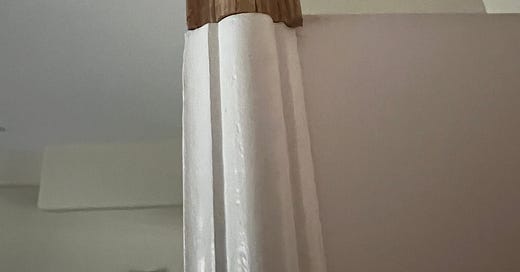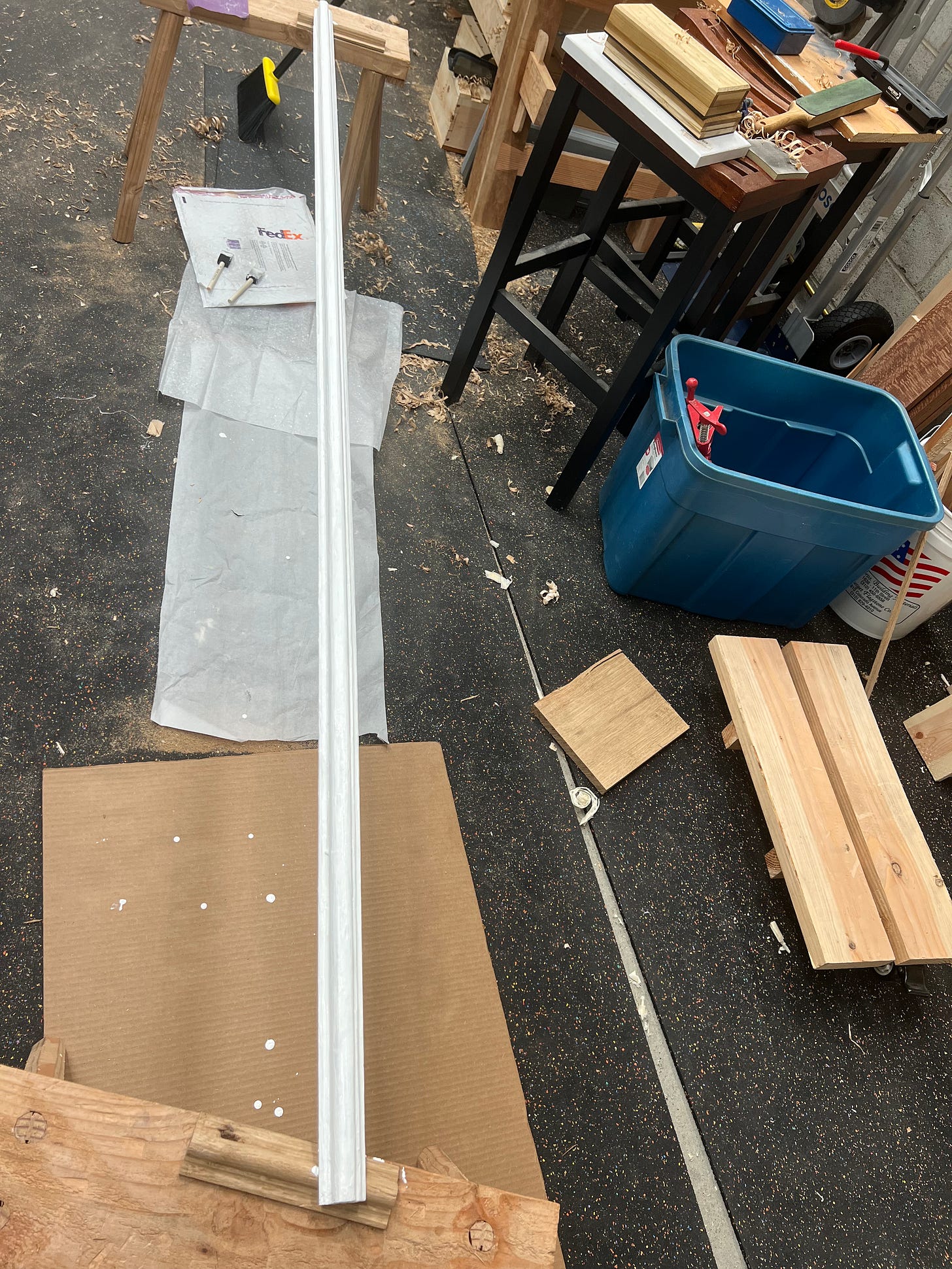I work with a bunch of Israelis. Sometimes the culture clash can be jarring, but usually it’s merely bemusing. Recently one of my American coworkers got a Rivian. The Israelis, excited to see it, asked how much it cost, which of course in the US is somewhere between awkward and offensive. My American coworker demurred, and the Israeli was confused…
When we moved into our new place we made a huge list of things to fix up or do. This post is about one of those todo items.
The entrance to our bedroom is a kind of french doorway. Unlike every other french doorway I’ve seen in my life, these doors do not meet in the middle and instead have a ~1/2” gap in the middle. To address this the original design included some symmetrical moulding nailed onto the smaller (typically closed) door to cover the gap.
The original moulding is softwood and given how exposed it is, it is unsurprisingly chipped and broken. You can see a close up in the picture below. The chips look far worse from inside the room, where they show exposed wood.
I already have a couple pairs of hollows and rounds and a couple rabbet planes that I got after reading Mouldings in Practice. I took this opportunity to really work on hand-made mouldings. You should really read the book, but the gist of the process is to rough out the pattern you are going for with a rabbet plane first. This is mostly because sharpening a flat iron is much easier than sharpening a curved iron, I guess. There is actually a lot to this first step, both in planning and execution. Basically you use the rabbet plane from multiple sides or angles to get close to the final moulding. Finally you use the hollows and rounds to get it the rest of the way there.
Initial Experimentation
I made a couple test pieces before starting on the final, 80” piece.
The second one was actually better than the final product, but 6” of moulding is a totally different animal than nearly 7’.
Process
The main difficulty for me in this project was that the moulding in question is longer than my workbench. I worked on it in sections, ensuring that the portion I was working on was fully supported.
I used holdfasts and battens made of scrap to make fences for the rabbet plane to run against. Initially I didn’t use battens but I found that I am likely to stray past my lines without support.
The actual hollows and rounds were like magic, producing the concave or convex curves exactly as intended.
Of course the rough replacement was imperfect in a bunch of ways, but it’s still an improvement:
Painting and Attaching to Door
I painted the moulding before attaching it to the door. This meant less possibility of getting paint on other things and allowed me to avoid having our room in shambles longer than it needed to be. Before painting I used some wood filler to fill in some tear out. I did a few coats, but I still think it could have been more. Painting is a lot of work.
I intended to nail the moulding to the door myself, but I either lack the skills or the quality nails to do that job. I got an air compressor that came with three different nail guns, and used that. While power tools are noisy and dangerous, it was fun to sink a dozen 1-1/4” brads into the work in about two minutes. I will definitely use this for future mouldings.
Finally I nailed the moulding to the door, filled in the nail holes with more wood filler, painted over the filler, and reattached the door.



This was a fun project, and I am proud of it every time I walk past it. It could be improved, but I think I just need more practice. All that said, my preference is joinery. Fitting pieces together to build functional furniture is more rewarding to me than decoration.
In Israel, bathrooms are fully private. Even in buildings that must support multiple bathrooms, each bathroom gets a door that closes all the way. Surely the American readers of this post are aware that we have the basically unprivate urinals, and the barely private stalls, in our bathrooms. My Israeli friend from the beginning expressed his surprise at how Americans are private with things like how much a car cost (surely a number that can be looked up with a brief internet search) but so unreserved with the bathroom stalls which have non-trivial gaps between the doors!











I'm sure your coworkers would have loved Hamburger Mary's in San Francisco in the '90s. The bathrooms were unisex and had no locks on the doors!
Hi Frew, Good work, this may help next time to hold your timber while moulding: How to Make a Sticking Board https://youtu.be/BNtqUzSRu8M?si=jFzy25k8oU7i8ngH Cheers David